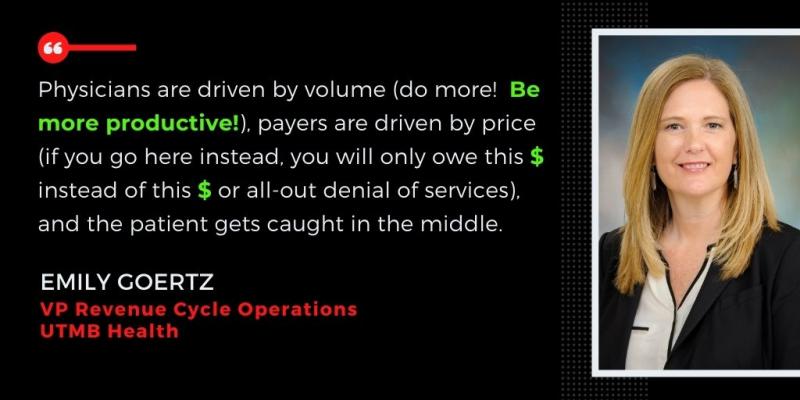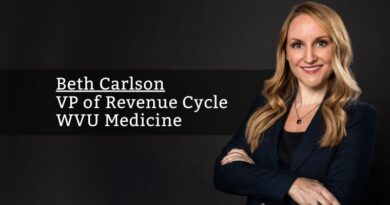Revenue Cycle Management in an Ever-Changing Environment
By Emily Goertz, VP Revenue Cycle Operations, UTMB Health
Revenue Cycle shops across the nation are constantly and consistently striving to make improvements to improve net revenue, reduce costs, and do more with less. This is a consistent theme we all march to in order to achieve collecting the most amount of money that is due to any organization. At the most basic level, that is all that we are trying to do – collect every dollar that is due to our healthcare facility so that we can continue to provide services for our patients. It should not be this hard. But it is hard. Every month, we review our denials and write-offs, look at our point of service collections, try to get physicians to document better, fight with our payers, and explain away the reasons why we do not get paid. Even if our metrics are comparatively good, there is still money that is not collected. Therefore, we do not achieve our contracted rates, even though we provide quality services to improve our patient’s lives in good faith effort. Ever-changing regulations, payer behaviors, and changing trends also impact the work that each of us juggles in order to keep our organizations financially afloat. We are constantly preparing for upcoming changes, re-evaluating staffing structures, and up-dating revenue cycle processes to maximize reimbursement and further engage staff across the organization in improvement efforts. We all know that the entire organization must be engaged in improving the right processes to make any improvements in dollars collected. All must be engaged to have a healthy and well-functioning inter-departmental healthcare team.
There are many things that revenue cycle shops can do to improve workflows and ultimately improve reimbursement. I am sure that organizations have attempted most of them in one way or another, and probably multiple times (that must be where the “cycle” comes from). One area that needs constant attention lies in the mid-cycle function of the revenue cycle. In addition to workflow improvements, this is where we must do a better job communicating with patients and improving the patient’s financial experience. There is an increased focus on price transparency and consumerism, and therefore, it is critical that we meet (exceed) the patient’s expectation of their financial experience. This is challenging because payers continue to get stricter on approving services and providers want to provide medically necessary services as quickly as possible. Physicians are driven by volume (do more! Be more productive!), payers are driven by price (if you go here instead, you will only owe this $ instead of this $ or all-out denial of services), and the patient gets caught in the middle. For the revenue cycle, pre-registration or pre-access departments are critical in preventing denials and really serve as “gate-keepers” for the organization but are unfortunately often viewed upon as barriers to access by physicians. However, to get paid for services, we must have enough time and enough information to financially secure an outpatient procedure before the patients get scheduled at all. We must also communicate accurate information to the patient prior to scheduling the procedure. By doing this, we protect the organization’s financial well-being, we are not viewed as the “barrier” (well, maybe), and most importantly, we do not put the patient in the middle. The patient has some ownership in the decision to proceed based on accurate information regarding their financial responsibility. It seems easy, right?
As we all know, staff across the organization must be engaged in process improvement or technology initiatives to make improvements. Although it takes people from across the organization to understand and engage, it is critical that staff in our revenue cycle shops are engaged and are willing to speak up and voice issues and challenges that they experience every day. All too often, someone will continue to do a meaningless function if they feel as though their job is threatened if their duties are automated. Staff can be re-allocated to areas that cannot be automated, such as the mid-cycle. There are too many opportunities and challenges to getting paid appropriately to eliminate staff from the revenue cycle. However, you can prevent the need to add staff by automating and reducing “touches” in the process to get a clean claim out the door. The more efficient that we can get, the better our collections performance.
As Revenue Cycle leaders, we are always looking for ways to continuously improve, motivate others, and achieve better results. In the revenue cycle, small wins can mean big dollars to an organization. We must continue to help people, including physicians, across the organization, understand the reasons for non-payment and attempt to engage their help. People also need to understand their role in achieving the organization’s goals. Meaningful work helps people see how their efforts contribute to outcomes and small wins will help get the organization moving in a better direction.



